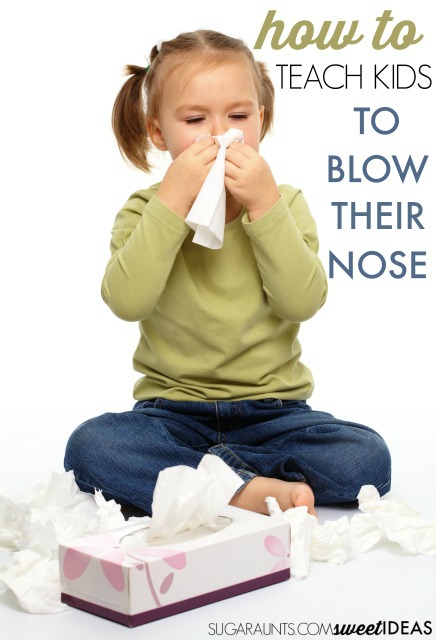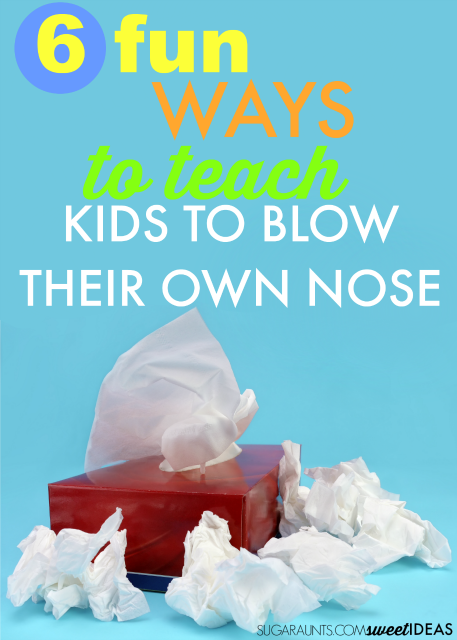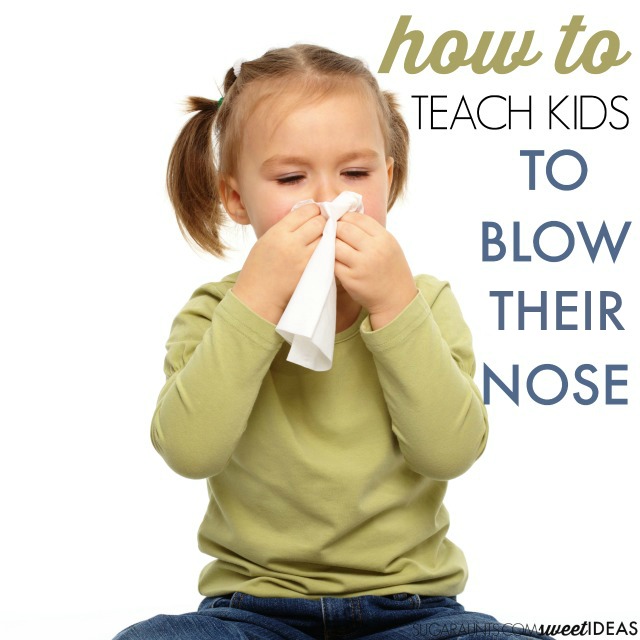Want to know how to teach kids to blow their nose so kids can blow their stuffy noses on their own? Many times, we see kiddos with booger-y, runny noses that don’t know how to blow their nose. They might not know how to blow their nose or even how to hold a tissue. Blowing a nose is a functional skill that occupational therapists may see come up in the classroom or at home. Read on for nose blowing tips for kids from an occupational therapist will help kids blow their nose with ease!
Teaching preschoolers to blow their nose is one of the practical life activities for preschool that impact not only functional performance, but learning, too. A stuffed nose effects hearing and auditory processing, which in turn can impact how letter sounds are perceived, verbal directions are heard, and even safety considerations.
How to Blow Your Nose
This time of year, kids get sick. Sometimes it seems like there are more visits to the pediatrician’s office than there is to the grocery store. With children back into the routine of school, there are more opportunities for kids to come into contact with germs from friends and teachers. As parents, one thing we know a lot about is runny noses. When our babies are born, it is usually not long before a runny nose has us and the sweet little baby up at night with the stuffy, congested breathing. When kids start to progress in their self care, they can start to become more independent with the task of blowing their own nose.
Blowing your nose includes steps that can be hard for kids to master:
- Knowing that their nose is stuffy or full (interoception, or an awareness of the body)
- Knowing to blow boogers instead of sniffing them up into the nose (interoception)
- Holding a tissue at the nose without crumbling it (fine motor skills)
- Blowing air through the nose and not the mouth (oral motor skills)
- Pressing on one nostril and then the other (fine motor skills, interoception)
- Knowing that all of the mucus or boogers are gone from the nose (interoception)
- Handling a messy tissue without spreading germs (fine motor skills and tactile sensory skills)
- Throwing away a tissue and washing hands (executive functioning skills, problem solving, sensory processing, fine motor skills)
And completing all of these tasks WHILE engaging in learning, social events, or performing other tasks. What a challenge for some of the kids we serve!
How can these steps of nose blowing be mastered by kids who struggle with fine motor skills, sensory processing concerns (including tactile or interoception issues), and executive functioning skills?
Tips to teach kids to blow their nose
Today, I’m sharing tips and tricks to help kids learn how to blow their own nose and to develop their ability to perform this portion of personal hygiene and functional skill ability. These are practical tips to teach kids that blowing the nose, wiping runny noses, washing hands when done, and how to use a tissue to blow a nose are all important aspects to take care of your nose.
For the younger children, you might think it is easier to just wipe a runny nose rather than allowing the young child to attempt nose blowing. You might even have the thought, “does blowing your nose help?” cross your mind. But, yes, it is very important to teach kids to blow their nose. And,
This is a great resource to add to a Montessori nose blowing lesson, because of the practical life skills that are addressed through nose blowing activities.
Teaching kids to blow their own nose can be tricky. Children who are typically developing find blowing their own nose to be difficult and children with special needs may have an especially troubling time with independent nose blowing.
There are important parts of the development of the child to consider when it comes to nose blowing. Knowing what a child typically should be able to do in this personal care task can help parents determine if teaching nose blowing is feasible at different ages. Other kids with sensory, fine motor, cognitive, or other struggles will fit into this developmental breakdown differently. You can read more on these areas concerns below.

Nose Blowing Development
While the runny noses that impact newborns seem to happen right away, as children age, you may wonder “When Can Kids Blow Their Nose?” There is much to think about in the nose blowing process…considerations such as body awareness, social awareness, grasping the tissue, and the actual nose blowing process.
Blowing a nose doesn’t come naturally. It’s a skill that needs to be taught. Parents that watch their little ones struggle with boogery, wet, runny noses often wonder when their child is old enough to blow their own nose. In fact, there are milestones that go along with this functional skill.
These are typical age ranges for the breakdown of skills needed for independence in nose care:
Age 1 – The child allows his or her nose to be wiped.
Age 1.5– Attempts to wipe nose without actually completing the task
Age 2- Wipes nose when asked
Age 2.5-3.5- Wipes nose without request
Age 2.5-3.5- Blows nose with request
It’s important to note that kids don’t always follow these developmental milestones and that every child is different. They typically developing child may not blow his or her own nose until age 5.
Just like any skill that a child completes, there are various ranges of development. In this post, you will find tricks and tips to help kids develop this skill.
For the child with special needs, independent nose blowing may develop more slowly as a result of concerns in other areas.
How to blow your nose: Fine motor skills needed
When blowing one’s own nose, there are fine motor components that are necessary. Eye-hand coordination, bringing the hands to midline, vision-obstructed motor control, pincer grasp, and pinch grip strength are necessary for managing a tissue. To address these needs, try building the skills needed for each area.
Here are strategies to build fine motor skills.
How to blow your nose: Sensory Skills needed
For a child, the process of blowing his or her own nose can be quite distressing.
Children with olfactory sensitivities may breathe primarily through their mouth, making the act of nose blowing difficult. A sensitivity to scents can cause an overreaction to the tissue that needs to be held near the nose.
To accommodate for these sensitivities, try using unscented tissues. Attempting the nose-breathing activities listed below can help.
There are tactile and olfactory sensory skills involved with nose blowing and managing a tissue, but also interoceptive skills.
Interoception is a sensory processing ability that tells us how our body feels and impacts functioning skills. This skills allows kids to understand and feel what’s going on inside their body. When a child struggles with the interoceptive sense, they may have trouble knowing when their nose is full, running, or stuffed. They may not realize they have a booger on their face or when they need to blow their nose. Interoception allows us to know when we are finished blowing our nose and when a child’s nose is empty or they’ve finished blowing.
Here is more information on sensory processing.
How to blow your nose: Cognitive skills needed
For young children, the process of completing each step of nose blowing can be a difficult process. Children need to maintain lip closure while breathing through their nose, one nostril at a time.
This multi-process task can be difficult for older children who demonstrate difficulty with cognition. To address these problem areas, try using a social story for the steps of nose blowing. A social story can also help children identify the appropriate time for attempting to blow their nose.
Executive functioning skills play a part in teaching kids to blow their own nose. The problem solving needed to identify when a stuffy nose impacts functioning is just one concern. Here are more ways that executive functioning impacts nose blowing:
- Initiation
- Planning
- Prioritization
- Attention
- Impulse Control
- Working Memory
- Cognitive Flexibility
- Foresight
If a child has a runny nose when in the classroom, they need to plan out how to get a tissue.
They need the foresight to know that if they don’t blow their nose, they will have a messy nose, runny boogers, or get an ear infection from sniffing too much.
They need to prioritize how to stop writing or reading and how to blow their nose in the middle of the classroom, and then what to do with the used tissue.
They need the impulse control to not sniffle or to throw their tissue in the garbage as opposed to the floor.
They need the working memory and cognitive flexibility to return to the task at hand once they blow their nose.
They need the ability to pay attention to the teacher or their assignment while they blow their nose.
What a lot of executive functioning skills are involved with nose blowing!
How to Blow your nose: Oral motor skills needed
In order to blow the nose, a child needs to maintain lip closure. This can be a very difficult task for children who exhibit oral motor problems. Oral motor skills impact feeding and breathing through the nose (as opposed to mouth breathing), but blowing the nose is impacted by oral motor skill development as well.
Here is more information on oral motor skills.

Strategies for helping kids learn to blow their own nose:
1. First practice nose blowing with the mouth.
Teach kids bring a tissue to their nose and practice blowing air out of their mouth. In this way, kids understand that blowing out air can move the tissue. They can then progress to closing their mouth and blowing air out through their nose.
2. Teach nose blowing when not sick.
This is an important factor in teaching kids to blow their nose. Parents typically do not consider nose blowing until there is congestion that interferes with breathing.
When kids are trying to learn to blow their nose and they are dealing with a runny or blocked nose, it can be overwhelming and frustrating for kids to breathe while holding their mouth shut. Try practicing nose blowing when the child is feeling well.
3. Teach kids to blow their nose by practicing to blow water.
Teach kids that they can use their nose to blow air through one or both nostrils at a time in order to blow ripples across the surface of water. Ask them to practice pinching their nose.
4. Blow a tissue ball to practice blowing a nose.
Tear a small piece of facial tissue and crumble it into a very small ball. Place it on the table surface and ask your child to blow the tissue on the table using their nose.
5. Blow on a mirror to see the fog to practice blowing a nose.
Ask your child to pinch one nostril closed and to blow air through their nose onto a mirror.
6. Teach the child about the spread of germs.
Try this children’s book and craft to get started.
7. Teach the child to hold one nostril with a tissue.
Use your hand to push down on one nostril. Kids can try this skill too, by trying to making the tissue dance with just one side of their nose. Call it a “tissue boogie” and get that tissue dancing by blowing it with the air from one nostril at a time.
8. Teach kids to blow their nose by over-exaggerating.
Over-exaggerate the breathing, closing mouth, and blowing through the nose without a tissue. Sit across from the child and play a game of “Simon Says” to copy the movements to take a deep breath, hold it in, close the mouth, and blow through the nose. You can find functional and practical Simon Says commands on our site.
9. Nose Blowing Social Story.
Try this nose blowing social story to teach kids to blow their own nose.


Colleen Beck, OTR/L has been an occupational therapist since 2000, working in school-based, hand therapy, outpatient peds, EI, and SNF. Colleen created The OT Toolbox to inspire therapists, teachers, and parents with easy and fun tools to help children thrive. Read her story about going from an OT making $3/hour (after paying for kids’ childcare) to a full-time OT resource creator for millions of readers. Want to collaborate? Send an email to contact@theottoolbox.com.







1 thought on “Teach Kids How to Blow Their Nose”
Comments are closed.